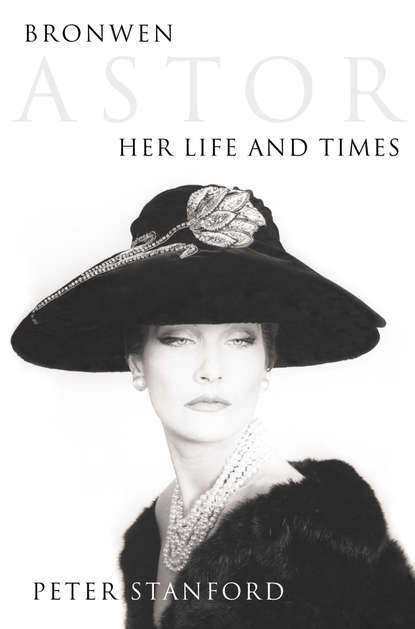По всем вопросам обращайтесь на: info@litportal.ru
(©) 2003-2024.
✖
Bronwen Astor: Her Life and Times
Настройки чтения
Размер шрифта
Высота строк
Поля
Equally important was the correct form for the catwalk-not then usually a raised platform but simply a walkway between rows of chairs ending in what was and remains known as ‘the cheese’ or ‘le fromage’ because of its resemblance to a slab of Camembert. To succeed as models, according to Ginette Spanier, the great Parisian couture house directrice of the 1950s, girls had to ‘swish their bottoms and stretch their legs out straight in front like a race horse, pirouetting at corners as though dancing an old-fashioned waltz.’
Other evening sessions covered make-up – at which Bronwen was a novice. At that time model girls were expected to turn up with their own shoes and do their own hair and make-up. Then there were hints on showing clothes off to best advantage – ‘wearing a jacket off your shoulders, that sort of thing’. And finally, another taste of the outwardly more buttoned-up 1950s, there was the etiquette of taking off and putting on clothes quickly, discreetly and demurely.
As Pat Larthe had spotted, nature had given Bronwen a spectacular walk. The lessons may have given it a little more polish, but it remained highly individual and one of her most devastating assets, something that was to make critics, designers and men sit up and take notice of her. Eugenia Shepherd, fashion doyenne of the New York Herald Tribune, later described her as that ‘husky, Welsh mannequin’ who ‘drags a coat down a runway as if she had just killed it and were taking it to her mate’.
The same openness that had made her a quick learner when Margaret Braund had fashioned St Joan out of a gawky schoolgirl at Dr Williams’ helped her to digest Larthe’s lessons in double-quick time. Despite her progress, at the end of the week Bronwen still found the agent adamant that she would not take her on. Her squint and her height would make her too hard to place. The current vogue was for petite girls with the gamine ‘little boy look’ – Jean Dawnay, its epitome, was five foot five and a half – rather than lanky, bony, long-legged women like Bronwen, who came in at just under six foot.
Yet once again, Bronwen displayed a remarkable single-mindedness. She couldn’t do much about her height, but the squint was easily cured. Raiding her savings, buoyed up by financial assistance from her parents, she went back to the surgeon who had treated her as a child and he operated once more on the lazy muscles behind her left eye. After a couple of weeks’ recuperation she was out knocking on the agents’ doors once more. Her friends marvelled at her perseverance. ‘I remember being full of admiration for her confidence and more so her resilience,’ says Diana de Wilton. ‘I just kept thinking I know I couldn’t have done that and that the very first time someone said no, I would have given up. But it was a new Bron. She wasn’t in the mood to be put off.’
Those same attributes also enabled her to ride out her family’s reaction to her decision to throw in teaching and try her hand at modelling. The Pughs were not frivolous people and the news that their daughter wanted to abandon her career in the classroom and spend her money on what must have seemed to them like a hopeless whim cannot have been easy to swallow. First she had refused Oxbridge. Then she had gone to drama school, but just when it finally looked as if she was back on the rails, working as a teacher, here she was giving it all up. They could not understand her motivation and she, still in shock over Erica, could not explain it-to them or even to herself. However, the Pughs were not so heavy-handed as to express their disappointment that she had abandoned what had been her anointed role. Indeed, whatever their misgivings, they helped her pay for her eye operation. They had taught their daughters independence, had deliberately avoided giving them either gender or class stereotypes, and realised that they were now reaping what they had sown. They may even have understood on some unspoken level, that modelling – like dressing-up and acting before it – fitted in with Bronwen’s penchant from earliest days for eye-catching gestures, the ‘look at me’ syndrome that she puts down to feeling insufficiently wanted as a child.
According to Bronwen they were relaxed but qualified any support with the hope that she wouldn’t come to regret her decision. Her future brother-in-law, Ron Barry, soon to marry Gwyneth, felt it went further: ‘I think that they regarded Bron as a bit of a mad-hatter after she turned to modelling. They didn’t understand what made her want to do it, but eventually they were very proud of her. Their only concern, and this was mainly later when her name was in every newspaper, was about all the people who were going mad about her and the endless partying. It was an entirely foreign world to them. They were still doing the quiet Hampstead life.’
Gwyneth was the most enthusiastic, applauding her younger sister’s nerve and, with an instinctive understanding of Bronwen, suspecting the real cause of her crusade. Very tall and skinny, with none of Bronwen’s new-found poise and self-confidence, Gwyneth suffered from poor eyesight and generally bad health as an adult, caused by heart problems; she wore heavy glasses and came to see her own body as a burden. The prospect of her extrovert little sister celebrating hers prompted her to express unselfish pride and encouragement. Gwyneth, her older sister Ann says, had already settled into a pattern where ‘she lived much more of an inward life. Bronwen was a much more open, outgoing sort of person.’ As a judgement from within the family, it shows the extent to which Bronwen kept that other side of her, the inward-looking, contemplative and, she believes, Celtic-influenced melancholy, well-hidden.
Too much can be made of the point since Ann was, of course, overseas with her new husband when she learned of Bronwen’s career change. ‘When I heard, I just laughed. I found it terribly hard to imagine why anyone would want to be a model.’ The oldest and youngest of the Pughs’ daughters had by this stage recognised that they were, despite a strong physical similarity, chalk and cheese. ‘I never felt Ann was envious of me, or me of her. We had both simply chosen very different lines of work and she couldn’t understand why anyone would want to do something so unacademic as modelling.’ If her goal since arriving at Dr Williams’ had been to follow a radically different path from her sisters, then Bronwen had finally and flamboyantly succeeded.
The only member of the Pugh clan to express outright disapproval of her boldness was her Goodyear grandmother down in Kent. To this Edwardian matriarch, the whole business of modelling seemed tawdry and she would have preferred her grand-daughter to give it a wide berth. A strict teetotaller, she once remarked to Ann of Bronwen’s career as a model girl: ‘I know that she lives on gin and sandwiches.’ However, she had little influence in such matters, even if it was partly a legacy from her late husband, given to each of his grand-daughters at twenty-one, that was allowing Bronwen to pay for the surgery on her eye and Pat Larthe’s course of lessons as well as to support herself until the hoped-for job offers came rolling in.
At first, on her return from Dorset, Bronwen shared a rented flat at 44 Harley Street with Diana de Wilton. Later she moved into her own place, first a small mews flat, and later in nearby Hyde Park Square, her home until her marriage. ‘I remember noticing,’ Diana de Wilton says, ‘not out of jealousy but curiosity how my room was always tidy and I would emerge from it looking plain. But Bron’s looked like a bomb had hit it, and then she would emerge looking lovely, immaculately dressed.’ She was developing her own style and her own, individual look, emphasising her Celtic eyes with her choice of colours and making the most of the aristocratic bearing her height, poise and strong facial bone structure gave her.
Eventually Bronwen persuaded the agent Peter Hope-Lumley to take her on his books. He was not quite so daunted by her height as Pat Larthe. And he was more successful at persuading his clients to take a chance on this unusual model girl than Jean Bell, the severe headmistress-type who had represented Bronwen for six months but failed to find her a single job. She had suffered numerous rejections; she was either too tall, too inexperienced, too unphotogenic, or not thin enough. ‘She just stood out,’ Hope-Lumley now says. ‘She was very exceptional. It was not only that she was much taller than the other models and had this air of distinction. There was something different in the way she walked. She was very good-looking rather than pretty.’ It is an observation reinforced by the interior designer Nicholas Haslam, then a youngster working on Vogue. ‘When you saw Bron, you wouldn’t say, “Oh, what a pretty girl,” you’d just say, “Wow!”’
Вы ознакомились с фрагментом книги.
Приобретайте полный текст книги у нашего партнера:
Приобретайте полный текст книги у нашего партнера:






